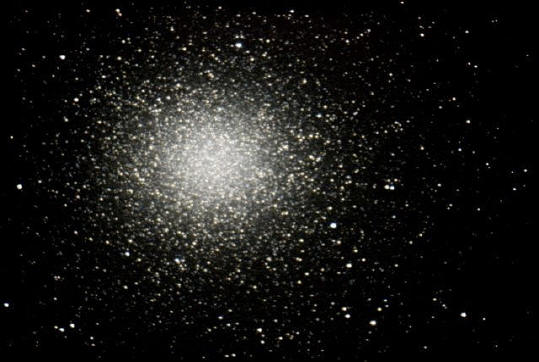|
The Night Sky of June
Dr. Wayne Wooten
Professor of Astronomy
For June 2011, the Moon will be new on June 1st, so the two weeks finds the moon waxing in the evening sky. On the 9th, the first quarter moon passes is high overhead at sunset in the evening sky. The waxing gibbous moon passes seven degrees south of Saturn in the SE on June 10th. Full moon, the Honey Moon, is June 15th, and
produces a total lunar eclipse for the other side of the world. We had our turn last December 21st, you may remember. The beginning of summer occurs at 12:37 PM CDT on June 21, the longest day of the year, with about 14 hours of daylight for the Gulf Coast. The last quarter moon is on June 23rd. The waning crescent moon passes five degrees north of Jupiter on the
morning on June 26th, and 2 degrees north of Mars in the morning twilight on June 28, and one degree west of Venus on June 30th, but both will probably be lost in the sunís glare then.
High up in the southern sky is the most beautiful planet, Saturn, just northwest of Spica, the brightest star in Virgo. Saturnís rings are now open about ten degrees; they will continue opening up wider until 2017, when they are tilted 27 degrees toward us and the Sun. You may also see some belts and zones on the planetís disk. The
largest, Titan, will be seen in any small telescope, but others will need larger scopes to spot.
The winter constellations are being swallowed up in the Sunís glare, but you might spot Sirius low in the SW as June begins. Sirius vanishes into the Sunís glare by mid-June, and this sets the period as "Dog Days", when Sirius lies lost in the Sunís glare. In reality, Sirius is about 20x more luminous than our star, but also lies
eight light years distant, while our star is eight light minutes away from us.
The brightest star in the NW is Capella, distinctively yellow in color. It is a giant star, almost exactly the same temperature as our Sun, but about 100X more luminous. Just south of it are the stellar twins, the Gemini, with Castor closer to Capella, and Pollux closer to the Little Dog Star, Procyon. By the end of June, all the
winter stars, like Sirius, are vanished behind the Sun.
Overhead, the Big Dipper rides high. Good scouts know to take its leading pointers north to Polaris, the famed Pole Star. For us, it sits 30 degrees (our latitude) high in the north, while the rotating earth beneath makes all the other celestial bodies spin around it from east to west.
If you drop south from the bowl of the Big Dipper, Leo the Lion rides high. Note the Egyptian Sphinx is based on the shape of this Lion in the sky. Taking the arc in the Dipperís handle, we "arc" SE to bright orange Arcturus, the brightest star of Spring. Cooler than our yellow Sun, and much poorer in heavy elements, some believe
its strange motion reveals it to be an invading star from another smaller galaxy, now colliding with the Milky Way in Sagittarius in the summer sky. Moving almost perpendicular to the plane of our Milky Way, Arcturus was the first star in the sky where its proper motion across the historic sky was noted, by Edmund Halley.
Spike south to Spica, the hot blue star in Virgo, then curve to Corvus the Crow, a four sided grouping. It is above Corvus, in the arms of Virgo, where our large scopes will show members of the Virgo Supercluster, a swarm of over a thousand galaxies about 50 million light years away from us. Much closer, in the back yard of our own
Milky Way, is the closest globular cluster, Omega Centauri. It is faintly visible to the naked eye directly below Corvus, and is a telescopic treat as seen in our photo of the month.

It approximates how this great "star ball" will appear in the larger telescopes in our club, and will be one of the most impressive things you can glimpse through the eyepiece of any telescope. This huge cluster is now suspected of being the surviving remnant of a dwarf galaxy, like our deep southern companions, the Large and Small
Magellanic Clouds, but with most of its gas and dust long ago stripped away by repeated passes through the disk of our own Galaxy.
To the east, Hercules is rising, with the nice globular cluster M-13 marked on your sky map and visible in binocs. While not as close as Omega Centauri, it is much higher in the sky, and also one of the top telescopic sights in good sized scopes. Several other good globular clusters are also shown and listed on the best binoc
objects on the map back page.
The brightest star of the northern hemisphere, Vega (from Carl Saganís novel and movie, "Contact"), rises in the NE as twilight deepens. Twice as hot as our Sun, it appears blue-white, like most bright stars. Its constellation, tiny Lyra, looks like a parallogram just south of Vega, but was the harp of Orpheus in Greek legends.
In the southeast, Antares rises about the same time as Vega does, in the brightest of all constellations, Scorpius. Antares appears reddish (its Greek name means rival of Ares or Mars to the Latins) because it is half as hot as our yellow Sun; it is bright because it is a bloated red supergiant, big enough to swallow up our solar
system all the way out to Saturnís orbit!
Read past issues of the Sky at Night
|